Welcome back to our coverage of Project Power Laggin’! Follow along as we take a tired 1979 Dodge W150 Power Wagon we found in Central Maine and transform it from a derelict roadside attraction to a dependable, powerful weekend workhorse that lives up to it’s given name! In this installment, we swap the ailing LA 318 engine for our Spray Can Rebuild Magnum 360! Will it run, or did we buy a cast iron lemon?
Last time we checked in on the ol’ Wagon of Laggin’, the original LA 318 was knocking harder than a pizza delivery guy on a Friday night, so we opted to snag a 138,000 mile Magnum 360 out of a 1997 Ram 2500 to replace it. We checked its vitals, deemed it “good enough” and slathered on some Chrysler Corporate Blue to complete the look. With the 318 getting worse with every startup, we made arrangements to act quickly to get the swap done. While this swap is fairly commonplace in the world of Mopars, most people either retain the stock EFI from the 90’s truck or run a carb. We were going to run our MSD Atomic 2 EFI and Holley Hyperspark ignition system, and considering that’s a rare combo on one of these rigs to begin with, we were in uncharted territory here. Would we succeed, or crash and burn hard?
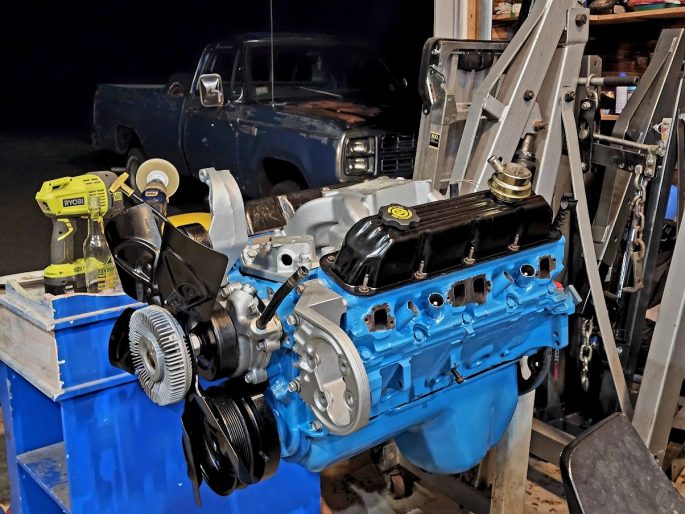
We decided to opt for a better facility than my driveway to do this swap, and a good friend of ours happens to have a home shop up the road with a two-post lift and plenty of tools, so while the truck was still running, we loaded up the 360, all the parts and tools we would need, and limped it over.

Here’s a final look at the 318 completely intact. This engine made it 43 years and only tried to kill itself once during our stewardship of this majestic beast. After the incident last year where it bent 5 pushrods and a valve touched the #1 piston due to the timing chain jumping off the cam gear, it was only a matter of time before something like this would happen. Enjoy your well-deserved retirement!
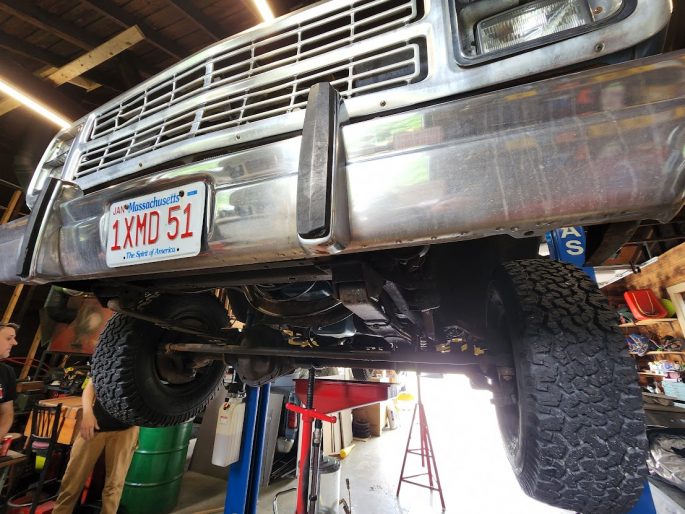
Having the lift for the engine swap process was key in saving time AND saving our backsides! Personally, I’m used to rolling around on the ground to get things done, but I can get used to having one of these! Getting access to components underneath the truck was as easy as raising the thing up, walking underneath, and getting to work. As Ferris Bueller once said, “It’s so choice. If you have the means, I highly recommend picking one up.”

Before long, we had all the fluids drained, the radiator removed, the headers unbolted, all wiring removed, the engine mounts unbolted from the frame, and the throttle body safely out of the way. Time to yank it out!
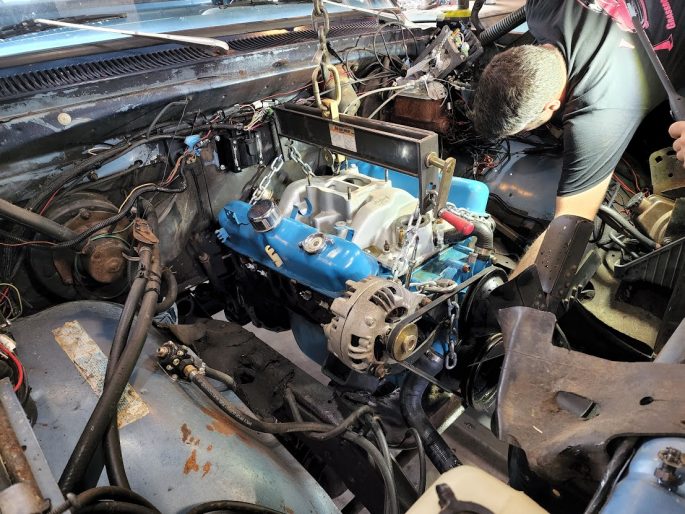
With the crane chains hooked up, it was time for the 318 to vacate its home forever. Engine load levelers are helpful in making sure you pull the engine out without any mishaps. You definitely don’t want to be doing the dangling engine shuffle with that cast iron lump high in the air!
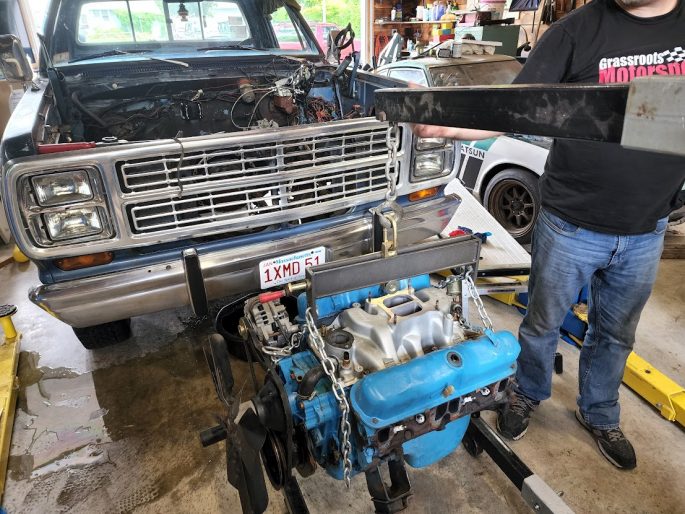
Soon, without any drama, the 318 was out!

Since we were swapping in a Magnum 360, the torque converter needed to come out as well. The Magnum 360 is externally balanced, and you need to make sure to use a neutral-balanced converter AND a weighted flexplate. The Magnum 360’s OEM flexplate came with our engine, and to bolt it to the converter, one of the mounting holes needs massaging.

As you can see here, the hole on the top is just slightly off. With the three others lined up, we marked off where we wanted to grind…

…And we hogged out the hole a bit. Doesn’t have to be pretty; it just has to work!

We also took the opportunity to replace the front seal on the transmission while everything was out of the way. Even though the seal was in good shape, it was cheap insurance to avoid a future leak.

We then introduced the 318 and the 360. Even though these two appear similar to the casual observer, there are many differences both on and below the surface. Hopefully the 318 gave the 360 a few tips before it was tagged in for service.

Let’s talk about Small Block Chrysler truck engine mounts for a minute. While the engine was out, we replaced the rubber mount isolators, which have been sitting on our shelf for a few years. Although the rubber isolators are the same, on LA engines, the 318 and 360 have different mounts. The big difference is the driver’s side mount, which is narrower on the 360. Before we performed the swap, I researched whether the 318 ones would work with Magnum 360, since the Magnum 360 retains the LA-style mounting tabs toward the front of the block. Without a definitive answer, we decided to find out the hard way.
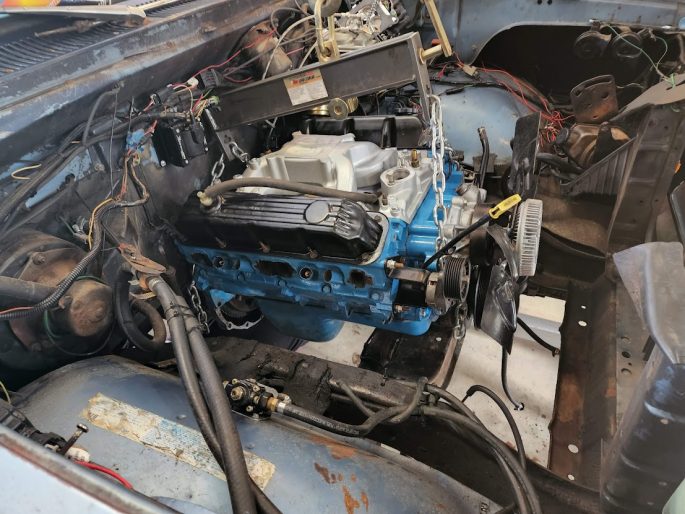
Lowering the engine into the engine bay was as easy as removing the old one, but it took quite a bit of re-leveling and shifting the engine around to get things to line up on the bellhousing.

While it’s tough to see, we had to add a spacer on the driver’s side mount to make up for the extra space. We will replace this mount with a proper 360 mount later, but this will get us home.

With the engine bolted to the bellhousing and the mount situation… well… situated, it was time to tackle the accessory drive. We wanted to retain the Magnum’s serpentine belt drive for a few reasons, including the simplicity of having one belt that is readily available in a pinch, the benefit of having a clutch fan, and not having a bunch of misaligned, squealing v-belts. One thing that needed to be kept from the old 318 is the power steering pump. The Magnum pump uses a pressure line with O-ring seals vs. the flared lines on the truck, so instead of having a custom line made, we just swapped pumps. Luckily, the old pump bolts right onto the later Magnum bracket.

Using a pulley puller/installer kit, the serpentine pulley from the Magnum pump presses right in place.

When we went to mount the bracket to the engine, however, we forgot that the old alternator/AC compressor bracket was part of the bolt sandwich, so we needed shorter bolts. Luckily, our buddy’s shop has some machine tools, so we cut down the stock bolts and gave them a taper for an easy fit. Took less time than going to the hardware store!
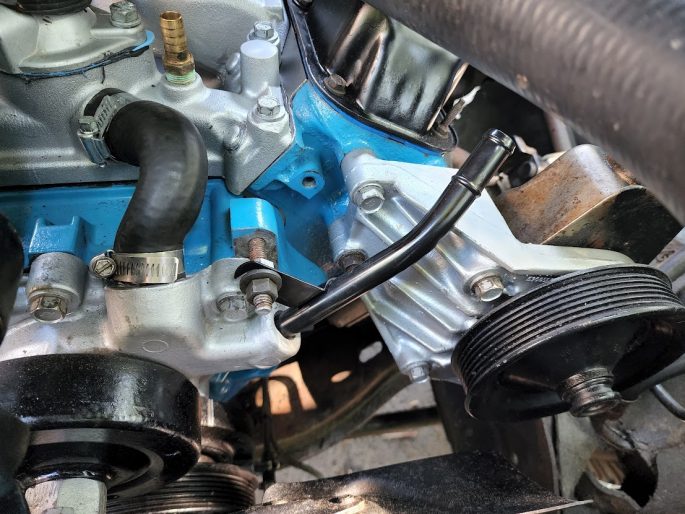
Another spot where we had to improvise was the water pump heater hose connection. Again, without the old alternator/AC compressor bracket, there was nowhere to bolt the outlet to. One of the old studs from that setup that we saved just happened to be the perfect length, so we added a nut and washer and voilà! Worked perfectly!

One of the benefits of running the Magnum’s front dress is getting to upgrade the alternator. The low output Magnum alternator is a 90 amp Denso unit, which is an upgrade over the 60 amp alternator that the truck previously had. Like the LA-style ones, they are externally regulated. The difference is the newer Ram trucks regulate voltage with the ECU, and the older ones like Power Laggin’ use Ye Olde External Voltage Regulator bolted to the firewall. Turns out, it’s a common mod for later Ram owners to bypass the ECU and run the older voltage regulator, and it’s simple!

Both the old and new style alternators use basically the same wiring, making it even easier. You have a battery positive wire and two field coil wires. The Magnum wiring harness also includes some extra grounds, but they are not necessary here. The biggest modification required is replacing the blade connectors on the field coil wires and the stock plastic-shrouded loop connector on the positive wire with regular loops as you see here.

And then, you bolt them on just like you would on the old alternator! That’s it!

After that, we bolted the headers onto the block. The Hooker Competition headers we installed last year for the LA 318 bolt right up to the Magnum heads with no drama.

Then, the throttle body was introduced to the Magnum 360, we ran the spark plug wires, and hooked up all the sensors, wiring, and coolant hoses.
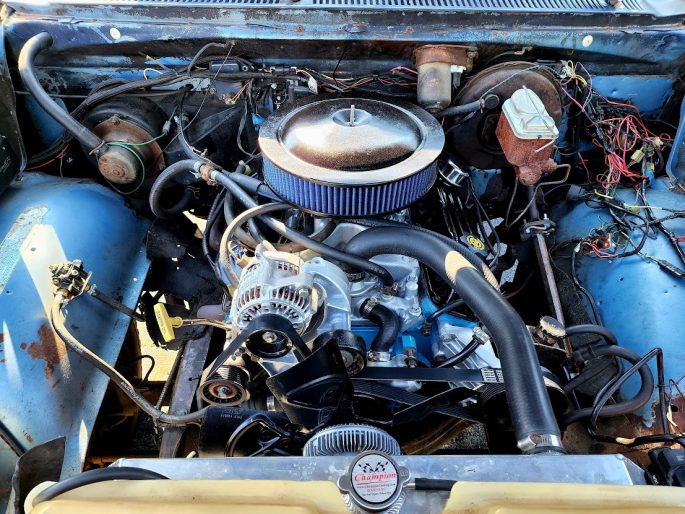
A finishing touch was hosing down the “patina” air cleaner with some Semi-Gloss Black. It was getting a little grungy, and this matches the valve covers better. Man, this looks great, like it belongs in there!

To get the engine started, we had to follow the Holley/MSD process of setting initial timing. Backing up a little: when we dropped the distributor in, we used the special alignment cap that came with the Hyperspark distributor to make sure it was in there properly. This dictates where the number 1 wire is with a small indent in the alignment tool. Mark the distributor, and start installing the cap and wires with that in mind.

When it came time to start it, on the handheld controller in the truck, we set the timing for something easily visible on the timing marks; in our case, 5 degrees BTDC worked for us. Then, we unplugged the fuel pump relay so we didn’t fill the throttle body with fuel. Next, we cranked it over, moved the distributor until we confirmed it matched with a timing gun, and locked down the distributor. Then, we adjusted it back to our optimal cranking timing and re-confirmed with the gun that it changed to what we set it to. Finally, the fuel pump relay was reconnected, and it was time to turn the key. It fired up instantly! Aside from a MAJOR oil leak from the oil sending unit falling off, there were no strange noises. After cleaning up the mess, we fired it back up and it ran better than expected!

If you remember our last installment, we decided to re-use the rod bearings and oil pump that came with the engine. That caused a bit of a ruckus in the comments section, with people calling us nuts. Personally, it was my decision. They looked good, and the inside of the engine was clean. Add to that the fact that supply chain issues were making the “good” bearings hard to obtain at the time and with other shortages in metallurgic components and quality control, we decided to just send it, knowing we could always fix it later if necessary. Well, I’m happy to report that this engine makes no knocky noises AND has excellent oil pressure. It shows 60PSI cold and drops to about 45-50PSI warm running 5w30 synthetic oil. For comparison, the old 318 showed 30PSI cold and about 0 PSI warm with 15w40 diesel oil and a bottle of Lucas Oil Stabilizer. In other words, we got a good one!
So, how’s it run?
In a word, fantastic! The 360 really runs great. There are no signs of internal issues, and the loudest part of the engine is actually the belt drive; the idler pulley bearing is a little noisy. The valvetrain and bottom end are very quiet, and there’s no strangeness in the exhaust note. Speaking of the exhaust, it sounded great with the 318, but it sounds even better with the 360 providing the rumble. It has a deeper tone thanks to the extra cubes, and it sounds downright MEAN!
Did it solve the Laggin’?
YES. Compared to the 318, this engine really does feel like it makes double the power, which was what we were hoping for. There’s no problem keeping up with traffic now, and off the line, it pulls HARD. There’s more power everywhere in the power band over the old 318, and it just makes driving it so much more fun. The kicker is that even though there’s a jump in power, the 360 is also more efficient! We are now seeing double digit gas mileage for the first time since we dragged this thing home. At one point, we were getting 5-6mpg. Now we are getting 10+. Still terrible, but we’ve essentially doubled both its power and efficiency with the Magnum swap!
What’s next on the list?
There’s still a lot to be done to this old rig. The added power has exposed a few flaws, like the need for better functioning brakes, as well as a host of maintenance items we need to address to make it safer, like U-joints, suspension bits, and tires. We’d also like to tackle the nasty interior and replace the rusty floor pans soon. But until then, we’ll be doing Truck Stuff!








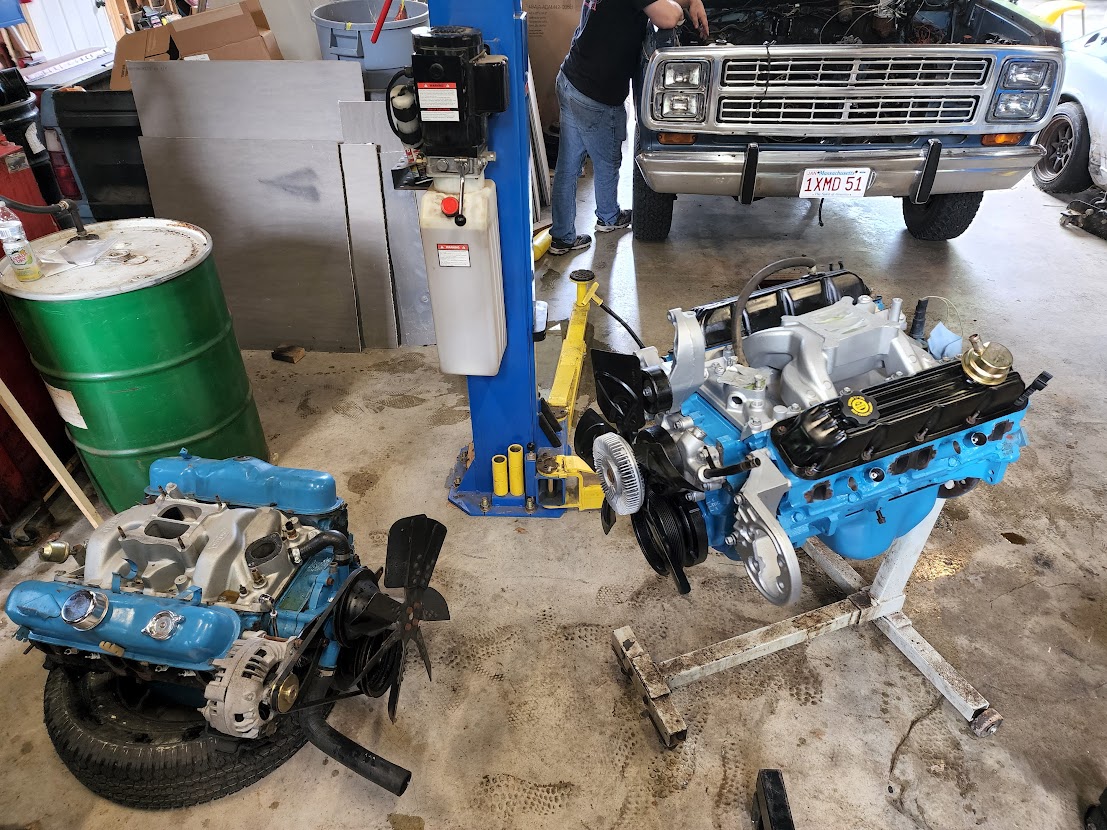





thanks for the report! i have an 85 W350 in desperate need of attention with a 360 that sucks gas like a champ, makes below average power and hemmorages oil out of every possible place… have been thinking of a magnum swap but i rarely use it so i convince myself to just add oil and pray…
i also have a 77 trailduster with 8 lug conversion with a 318 2 barrel that can barely get out of its own way and smokes heavily upon first startup… biggest redeemin quality is that it delivers about twice the mileage as the 360 in the W350… i even kinda love its thrifty demeanor but probably would be willing to swap a magnum 5.2 or 5.9 for the power benefits… both trucks roll on 35s